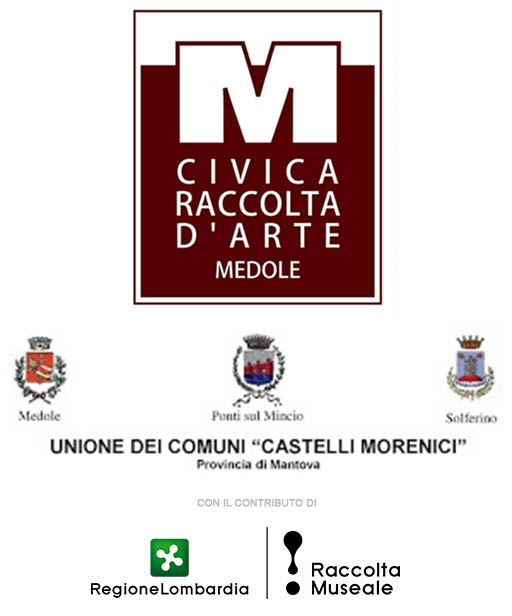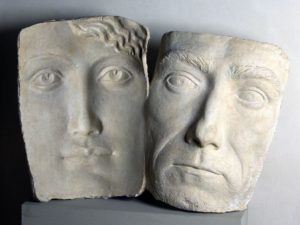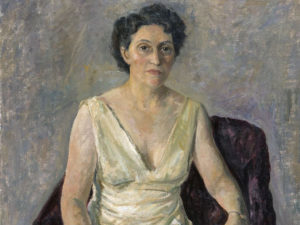4 Faces: Gianpietro Moretti and Carlo Zanfrognini
AUDIOGUIDA:
Leaving the main vestibule, you pass the elegant cornice bordered by an ashlar that creates perspective and, climbing the main staircase in white marble, you come to Enigma, a work by Gianpietro Moretti. Although the material used seems the same as in Brigoni’s works, the Brescian artist’s plaster comes from another universe. We are in the presence of a meticulous work by a great master sculptor. This double portrait plays on the theme of the imago of Roman origin, in which a portrait of the deceased is kept in the same space and time as the daily life of the family. This interpretation intersects with the more Pirandellian interpretation of man and his masks: a thousand portraits that hide a true identity that may not even exist except in its own interpretations of reality.
You then enter the main hall, the most prestigious and fascinating room in the building. The dimensions of the large hall are significant for this building: 9 meters long by 7 meters wide and about 7 meters high. The walls have an elegant decoration that imitates pink brocade with phytomorphic motifs, rising towards an exquisite, ornately decorated vault. The large hall has six overdoors that embellish the otherwise understated openings on three sides. Starting from the first panel that presents itself to the visitor, the one you see before crossing the threshold of the room, and continuing round clockwise, we can see a mountain landscape crossed by a vertical line formed by a flock of sheep being led home by a shepherd. The theme of the second panel seems to be a rural wedding: in fact, you can make out a small group of young people dressed for a celebration going through a gothic gateway, probably after leaving the small church in the background. The bucolic theme also continues in the third panel, where it takes on a more mythological resonance; the theme of bathers that would have great success in the nineteenth and twentieth century (just think of Degas, Renoir, or Cézanne) seems to touch on the myth of Diana and Actaeon here. The fourth panel abandons mythical and distant lands and times to return to a more immediately real territory: another small scene of country life, where the joyous calm of the grape harvest on the left contrasts with the hunt on the right. The scene seems to take place in place that is not clearly identified, but is undoubtedly nearby. Historians who have studied the image have focused in particular on the imposing Monte Baldo, adorned with an elegant snowy peak. The fifth panel shows a winter scene, with the small church of San Rocco perfectly centred and embellished with a dusting of snow, while, right in the foreground, a coachman sets off at great speed in his wagon. The last scene focuses on the daily life of a country court. The stillness is the perfect conclusion to this cycle of paintings that delineate both the refined aesthetic taste of the Ceni family and the local charm of the village and its immediate surroundings. In this superbly rich room, you can admire Carlo Zanfrognini’s elegant piece Il ventaglio, a work by the Mantuan painter in his full maturity, in which vague hints of the Chiarismo movement and the avant-gardes are diluted in a totally personal and confident style.
- Gianpietro Moretti, Enigma, 2005
- Carlo Zanfrognini, Il ventaglio (Ritratto della moglie Albina), prima metà XX sec.


